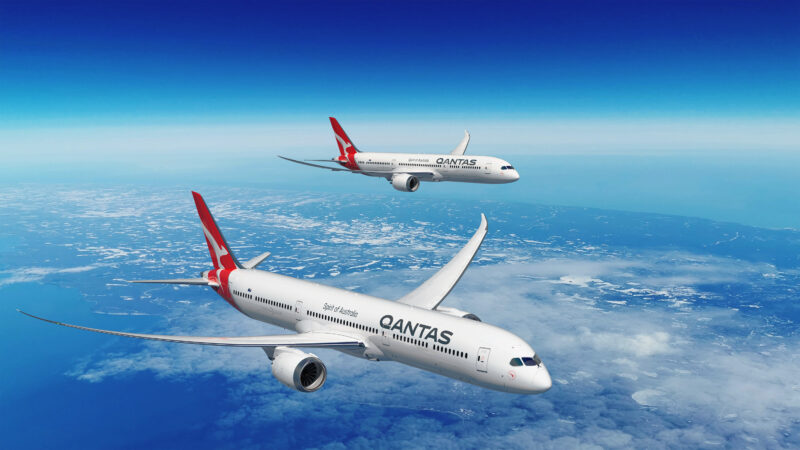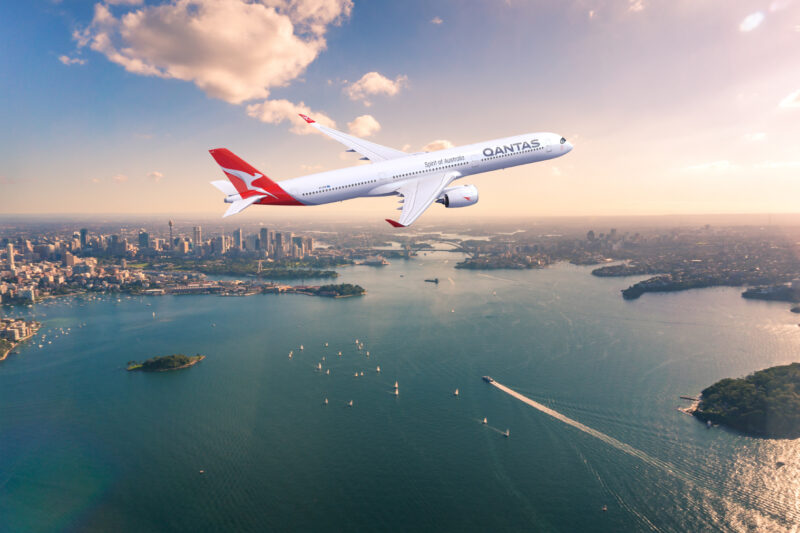The Qantas Group is continuing to plan out its fleet renewal, with the airline securing further widebody aircraft from Airbus and Boeing.

More widebody aircraft are on the way for Qantas
The firm order covers the renewal of the Airbus A330 fleet that is currently in service, with an order of 24 aircraft.
This is split between 12 Airbus A350s and 12 Boeing 787s arriving from 2027 into the next decade.
The breakdown of the order is:
- Four Boeing 787-9 and Eight 787-10 aircraft – with deliveries starting in 2027.

- 12 Airbus A350-1000s, with deliveries starting in 2028.

The Group has also negotiated additional purchase right options, split evenly between both manufacturers, to give flexibility for future growth and ultimately replace its 10 A380s with A350s from around 2032 onwards – giving the A380 fleet a service life of 24 years when they’re replaced.
Qantas has named its international fleet renewal ‘Project Fysh’ in honour of Sir Hudson Fysh who co-founded the airline and was Managing Director when it commenced international flying in 1935.
Qantas’ A330 aircraft mostly operate on international flights to Asia and the United States as well as some domestic flights. The longer range delivered by the 787 and A350 aircraft on order means they will be able to operate all the routes on the airline’s current international network, as well as open up new ones to the airline.
The average age of Qantas’ A330 fleet will be 21 years at the time the replacement program starts in 2027, which is in line with the Group’s typical replacement profile. Aircraft scheduled to leave the Qantas fleet towards the end of the replacement program will undergo a cabin refurbishment from 2025, including next-generation seats in the Economy cabin.
As part of the deal with both Airbus and Boeing, Qantas will secure access to up to 500 million litres of Sustainable Aviation Fuel (SAF) per annum that would start to flow from 2028. Access to these supplies will be enabled by partnering with Boeing and Airbus on SAF projects, including in the United States.
Qantas expects to purchase the SAF at favourable prices due to supportive government policies in the US.
In Quotes
Qantas Group CEO Alan Joyce said:
“This is another multi-billion dollar investment in the national carrier and it’s great news for our customers and our people.
“It’s in addition to the 149 firm aircraft we still have on order to continue renewing the domestic fleet for Qantas and Jetstar, and for the non-stop Project Sunrise flights to London and New York.
“Both the 787 and A350, and the GE and Rolls Royce engines fitted to them, are thoroughly proven and extremely capable.
“These are generational decisions for this company. The aircraft will arrive over a decade or more and they’ll be part of the fleet for 20 years. They’ll unlock new routes and better travel experiences for customers, and new jobs and promotions for our people,” added Mr Joyce.
CEO designate Vanessa Hudson said:
“We effectively started these negotiations off the back of the narrowbody and Sunrise campaigns, and that momentum helped deliver pricing and delivery slots that makes this an excellent opportunity for the Group.
“Our ability to afford these aircraft comes from years of restructuring and strengthening our balance sheet, and our confidence about the future. Our entire fleet plan has a lot of flexibility built into it so we can slow down deliveries or, within reason, bring them forward depending on the broader market.
“The phasing of these orders mean they can be funded within our debt range and through earnings, on top of continuing shareholder returns in line with our financial framework.
“This deal gives the Qantas Group access to sustainable aviation fuel supplies out of the United States, making us one of the first airlines in the world to have a pathway to achieving our 2030 SAF targets,”
Continuing the fleet upgrade
Qantas is continuing to scale up its operations, with the first two QantasLink A220 aircraft due by the end of this calendar year, with subsequent deliveries expected to be delayed by up to four months as a result of supply chain disruption.
Meanwhile, the first of seven mid-life A320 family aircraft that Qantas and Jetstar Asia need to grow their operations will arrive before the end of December 2023.
Supporting the thinner operations, 22 E190s wet-leased from Alliance Airlines are scheduled to have joined the Qantas fleet by the end of December 2023.
In terms of the cargo fleet, two more A321 Passenger-to-Freighter aircraft are expected to arrive by the end of December 2023.
The future fleet is shaping up, with Jetstar’s 18 Airbus A321LRs on track to enter the fleet by the end of calendar year 2024, with a further 20 A321LRs and A321XLRs set to be delivered by calendar year 2029, whilst the first of the Project Sunrise Airbus A350-1000 ULRs are to arrive in 2026.
It’s going to be a busy time as Qantas focuses on growing its network, as well as adjusting its fleet. With the need to renew aircraft, it seems that the airline is moving to the newer platforms – when the airline could have played it safe and selected the A330neo. In this case, it is playing the expansion game, with aircraft that can exceed the mission profile of existing aircraft.
We’ll have to see how they are configured when the deliveries start rolling out.
Welcome to Economy Class and Beyond. Your no-nonsense guide to network news, honest reviews, in-depth coverage, unique research, as well as the humour and madness I only know how to deliver.
Our Social Media pool has expanded. You can find us across most networks as @economybeyond on Twitter, Mastodon, BlueSky, Threads, as well as Instagram!
Also, remember that we are part of the BoardingArea community, bringing you the latest frequent flyer news from around the world.